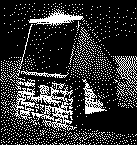 (click on any picture for a large version)
(click on any picture for a large version)
| Radio Astronomy Introduction | NRAO Education &Tour programs | Historical telescopes in Green Bank | to Green Bank home page | to NRAO home page |
 (click on any picture for a large version)
(click on any picture for a large version)
This horn antenna, now displayed in front of the Jansky Lab at NRAO in Green
Bank, WV, was used by Harold Ewen and Edward Purcell, then at the Lyman
Laboratory of Harvard University, in the first detection of the 21 cm emission
from neutral hydrogen in the Milky Way. The emission was first detected
on March 25, 1951.
Read about the prediction.
Read about the discovery.
Edward Mills Purcell (b.Taylorville, Ill., August 30, 1912; d.March 7, 1997) grad. Purdue univ.1933, PhD Harvard, 1938. Worked on radar research during World War II. Shared the 1952 Nobel Prize with Felix Bloch for development of the nuclear magnetic resonance method of measuring magnetic fields in the nuclei of atoms.
Harold Irving Ewen (b. Chicopee, Mass., March 5 1922) Graduated Amherst College 1943, MA(1948) and PhD (1951) from Harvard Univ. (Later was President of Ewen Knight Corp (1952-) and Ewen Dae Corp. (1958-)).
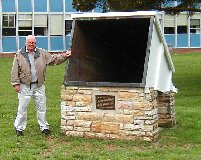 "Doc" Ewen pictured with his horn on the occasion of a visit to NRAO-Green Bank
May 22, 2001. He had not seen his horn antenna since 1956!
"Doc" Ewen pictured with his horn on the occasion of a visit to NRAO-Green Bank
May 22, 2001. He had not seen his horn antenna since 1956!
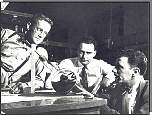 In 1950, H. I. ("Doc") Ewen was working 40 hours a week
designing and building apparatus for the new cyclotron at Harvard.
In addition, during nights
and weekends, he was working on completing a doctorate in physics by building a
receiver to detect the 21 cm line of neutral hydrogen, supervised by Purcell.
In 1950, H. I. ("Doc") Ewen was working 40 hours a week
designing and building apparatus for the new cyclotron at Harvard.
In addition, during nights
and weekends, he was working on completing a doctorate in physics by building a
receiver to detect the 21 cm line of neutral hydrogen, supervised by Purcell.
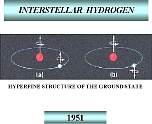 The original paper by Van de Hulst predicting the existence of the
21 cm line
expressed doubt that the line would be detectable. A paper
by Shklovski in 1948 was more optimistic. Ewen and Purcell assumed that the
Dutch were probably not working on detecting the line and that the Russians
might soon be. They could probably make the first
sensitive detection attempt. It seemed likely that the experiment would
yield a negative result, but the experience would be worth the trouble
and a well defined upper limit to the 21 cm line emission strength would
be important.
The original paper by Van de Hulst predicting the existence of the
21 cm line
expressed doubt that the line would be detectable. A paper
by Shklovski in 1948 was more optimistic. Ewen and Purcell assumed that the
Dutch were probably not working on detecting the line and that the Russians
might soon be. They could probably make the first
sensitive detection attempt. It seemed likely that the experiment would
yield a negative result, but the experience would be worth the trouble
and a well defined upper limit to the 21 cm line emission strength would
be important.

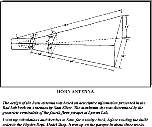 Purcell asked for, and received, a grant of $500 from the Rumford Fund of the American Academy
of Arts and Sciences for the costs of materials for building the antenna,
waveguide, and electronic components.
Purcell asked for, and received, a grant of $500 from the Rumford Fund of the American Academy
of Arts and Sciences for the costs of materials for building the antenna,
waveguide, and electronic components.
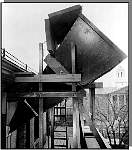 Ewen proceeded to design the horn antenna and the mixer and receiver, consulting with experts
in these fields, including Sam Silver on antenna design and Bob Pound on mixers.
The receiver used a frequency switching technique to cancel out background noise,
a novel technique for astronomy at the time.
Ewen proceeded to design the horn antenna and the mixer and receiver, consulting with experts
in these fields, including Sam Silver on antenna design and Bob Pound on mixers.
The receiver used a frequency switching technique to cancel out background noise,
a novel technique for astronomy at the time.
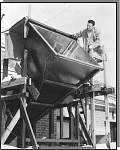 Ewen installed the completed horn antenna just outside a window on the
fourth floor of the Lyman Lab at Harvard, with the waveguide leading
in through the window to the receiver and recorder.
Ewen installed the completed horn antenna just outside a window on the
fourth floor of the Lyman Lab at Harvard, with the waveguide leading
in through the window to the receiver and recorder.
He had to contend with some unexpected hazards. In a heavy rain, the horn antenna acted as a funnel, flooding the lab, when the drain became plugged up. Also, during the winter, passing students found the horn a tempting target for snowballs.
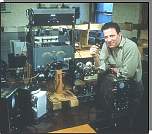 This shows Ewen with the completed receiver at the time of detection.
This shows Ewen with the completed receiver at the time of detection.
The whole project, from receipt of the $500 to detection of the line, took
one year. Since the work was done on the weekends, the total time spent
working on the project was (2/7)x12 = 3.4 months.
After detecting the 21 cm line, Ewen learned that Prof. Van de Hulst was spending a sabbatical year at Harvard. Ewen wrote:
|
At the suggestion of Purcell, I went to the
Harvard Observatory, in mid April, to meet
and talk to Van de Hulst for the first time,
and to tell him about the discovery.
Ed told me that Van de Hulst was teaching a
course at Harvard during the spring term.
It was the same course that he taught at
Leiden, during the prior fall term. When I
met with Van de Hulst at the Observatory he called
Oort, and I talked with Oort for nearly an
hour describing the switch frequency technique.
This was the first time that we learned the
Dutch had been searching for the line for
several years. Had we known, we would not
have tried.
...... Doc Ewen |
The Dutch group adopted Ewen's frequency switching technique and succeeded in detecting the line on May 11.
A further confirmation of the detection was made by Australian radio astronomers. This came about because Frank Kerr was on a fellowship at Harvard that year, on leave from the CSIRO Division of Radiophysics in Australia. On hearing about Ewen and Purcell's discovery, he wrote to J.L. Pawsey describing the experiment. Christiansen and Hindman, members of Pawsey's radiophysics group, built a receiver that used frequency switching, and were able to first detect the line on July 12.
The American and Dutch results were published in the same issue of Nature: Ewen and Purcell, Nature v.168, p.356, 1951; and Muller and Oort, Nature v.168, p.357, 1951. These were followed by a brief note in the same issue from Pawsey mentioning that Christiansen and Hindman had also detected the line. The Australian results were published more fully later: Australian J. Sci. Res., vol. A5, p. 437, 1952.
In the following years, observations of the neutral hydrogen line were
done with increasing accuracy by numerous
astronomers, primarily Dutch, American, and Australian.
The technique proved to be successful in mapping the large-scale
distribution of matter in the galaxy. Observations of the 21 cm line remains a
very important branch of radio astronomy to this day, resulting in ever more
detailed understanding of the interstellar medium in our galaxy, and in
studies of external galaxies.